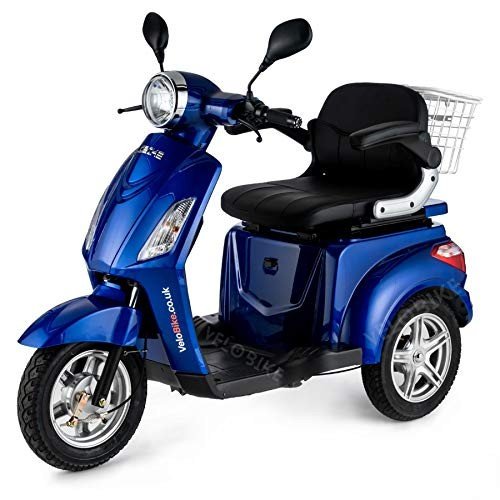Navigating the World of Mobility Scooters: A Comprehensive Guide
In an age where mobility is significantly recognized as a fundamental aspect of lifestyle, the need for assistive gadgets has actually risen. Amongst these, mobility scooters stand out as a flexible and empowering choice for people with mobility difficulties. This thorough guide explores the world of mobility scooters, using insights into their types, advantages, buying considerations, and maintenance suggestions.

Comprehending Mobility Scooters
Mobility scooters are motorized automobiles developed to help people with mobility issues in moving around more easily and individually. They are especially beneficial for those who find walking challenging due to conditions such as arthritis, multiple sclerosis, or post-surgical healing. Unlike manual wheelchairs, mobility scooters need very little physical effort, making them an outstanding choice for extended use.
Types of Mobility Scooters
Three-Wheel Scooters
- Pros: More maneuverable, lighter, and simpler to save.
- Cons: Less stable on rough terrain.
- best 8mph mobility scooters uk shop Online For motorized mobility scooters: Indoor and smooth outdoor surfaces.
Four-Wheel Scooters
- Pros: More steady, better on rough terrain, and can carry much heavier loads.
- Cons: Bulkier and less maneuverable.
- Best For: Outdoor usage, particularly in parks and on unequal surfaces.
Portable Scooters
- Pros: Lightweight, collapsible, and simple to transport.
- Cons: Limited range and speed.
- best mobility scooter uk For: Travel and occasional use.
Durable Scooters
- Pros: Built to handle much heavier users and rugged environments.
- Cons: More costly and less portable.
- Best For: Users over 300 pounds or those who require to browse rough terrain.
Standing Scooters
- Pros: Provide a standing position, which can be advantageous for users who can not sit for long periods.
- Cons: Limited stability and variety.
- Best For: Users who choose standing and need short-distance assistance.
Benefits of Mobility Scooters
Improved Independence
- Mobility scooters enable users to take a trip longer ranges without tiredness, allowing them to participate more completely in everyday activities and gatherings.
Improved Safety
- With features like seat belts, anti-tip wheels, and brake systems, mobility scooters offer a much safer alternative to manual wheelchairs and walking help.
Convenience and Support
- Adjustable seats, backrests, and armrests ensure a comfy trip, reducing the stress on the user's body.
Cost-efficient
- While the preliminary financial investment can be substantial, mobility scooters are frequently more economical in the long run compared to frequent taxi rides or specialized transportation services.
Social Inclusion
- Mobility scooters assist in greater social interaction by allowing users to take part in community activities and keep a more active lifestyle.
Elements to Consider When Buying a Mobility Scooter
User Needs and Abilities
- Assess the user's physical condition, mobility needs, and everyday activities to identify the most suitable kind of scooter.
Size and Weight Capacity
- Ensure the scooter can accommodate the user's size and weight comfortably and securely.
Variety and Speed
- Consider the normal range and speed needed for everyday use. Some scooters have a range of up to 30 miles on a single charge.
Portability
- If travel is a priority, choose for a portable scooter that can be quickly disassembled and transported.
Upkeep and Support
- Choose a respectable maker that provides trusted client service and upkeep assistance.
Budget
- Set a budget and explore alternatives that use the very best value for money. Consider funding choices and potential insurance protection.
Upkeep Tips for Mobility Scooters
Regular Cleaning
- Tidy the scooter regularly to prevent dirt and debris from impacting its performance. Use a soft fabric and mild cleaning agent.
Battery Maintenance
- Follow the manufacturer's guidelines for battery charging and maintenance. Routinely examine the battery level and prevent deep discharges.
Tire Inspection
- Inspect the tires for wear and correct inflation. Change or fix as required to ensure a smooth and safe trip.
Lubrication
- Oil moving parts such as the chain and equipments to decrease friction and avoid wear.
Professional Servicing
- Schedule routine professional maintenance to deal with any issues and ensure the scooter stays in optimum condition.
FAQs About Mobility Scooters
Are mobility scooters covered by insurance?
- Some insurance coverage plans, including Medicare, might cover the expense of mobility scooters under specific conditions. Inspect with your provider for specific details.
Can I utilize a mobility scooter inside?
- Yes, numerous mobility scooters are developed for both indoor and outside usage. Guarantee the scooter appropriates for the type of surfaces you will be browsing.
How fast can small mobility scooter for sale scooters go?
- The speed differs by design, however most mobility scooters have an optimal speed of 4 to 8 miles per hour.
Do I require a license to run a mobility scooter?
- In the majority of nations, a license is not needed to run a mobility scooter. However, it is essential to follow regional policies and traffic laws.
Can I take a trip with a mobility scooter?
- Numerous mobility scooters are developed to be portable and can be disassembled for travel. Talk to airlines and transportation service providers for particular requirements.
Mobility scooters are a transformative tool for people with mobility obstacles, using a mix of self-reliance, safety, and comfort. By understanding the different kinds of scooters, considering key purchasing elements, and following upkeep best practices, users can take advantage of their mobility scooter and lead a more active and satisfying life. Whether for everyday commutes or leisurely outings, a well-chosen mobility scooter can be an important companion on the journey to boosted mobility scooter to buy and lifestyle.







